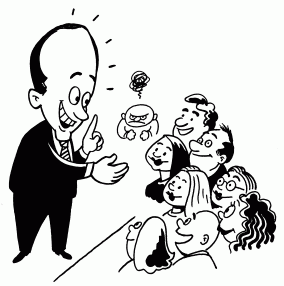
Years ago I used to focus on the worst members of the audience hoping to improve customer experience. The ones who crossed their arms and legs, never smiled, hardly said a word or took a single note throughout the day. I felt the need to “win them over” to prove my ability as a speaker and a trainer. I thought winning them would improve customer experience.
I’ve learned something over the years: Some people do not want to be won over – and that’s OK. It’s not possible to improve customer experience for everyone.
Now I focus on the audience members who do respond with smiling, nodding, taking notes, asking questions and laughing along with my stories. This gives me a lot more energy when I work, and also makes those participants feel appreciated and does much to improve customer experience for them.
And guess what? By the end of my presentations, most of the tough nuts have cracked themselves. Even tough nuts sometimes want to join the party – but they don’t want someone else to do the cracking.
This can be equally true with members of your staff or service team. Some people inside your organization can be real tough nuts, sticks-in-the-mud, fuddy duddies, old-timers, or even new-timers who don’t want to support a change, improvement or new program.
What should you do? Should you work extra hard to win them over? I suggest otherwise.
Instead of focusing on the few who don’t want to support new ideas, focus on those who are enthusiastic, helpful, optimistic about change and generally inclined to make new things work.
Think about it: Every ounce of energy you put into the enthusiastic members of your team comes back to you in support, ideas, action, initiative and positive effort. Every ounce of energy you put into the “tough nuts” gets you what? A worn-out nutcracker and a failed effort to improve customer experience in many cases.
Here’s one example: A prestigious hospital asked me to help improve the morale among the nurses in the operating theaters. There were 86 nurses on the team, but senior managers were most concerned with four long-serving staff who had become negative and reluctant.
I studied the situation carefully and recommended they ignore those unwilling or uninterested in change. Instead, we focused every ounce of effort on working with those nurses who wanted to work toward a better culture.
Within months, three of the tough nuts loosened up and started contributing good ideas. They were welcomed with appreciation for their wisdom and the quality of their contributions.
The other tough nut never cracked; she left the hospital and went to work elsewhere. Funny thing, within a few months, no one missed her.
Key Learning Point To Improve Customer Experience
In life, with staff, customers and everyone else on this planet, some will be keen and helpful and eager to see you win – and others will not. Be careful where you focus your efforts to improve customer experience.
Action Steps To Improve Customer Experience
Identify which of your staff are most constructive and helpful in bringing new plans to light. Tell them how much you appreciate their efforts and support. You will find you get even more as a result of your effort to improve customer experience (or staff experience). Don’t ignore the tough nuts, just don’t give them any more attention than they require. In time they will join the successful crowd, or they will leave. In which case, let them go and focus efforts to improve customer experience on others.
—————————————————————————————————————————–
You may use this article in your free newsletter, website or publication providing you include this complete statement (below) with active links to the websites:
Copyright, Ron Kaufman. Used with permission. Ron Kaufman is the world’s leading educator and motivator for upgrading customer service and uplifting service culture. He is author of the bestselling “Uplifting Service” book and founder of Uplifting Service. To enjoy more customer service training and service culture articles, visit www.RonKaufman.com.
For commercial use of this article in a paid newsletter, publication, or training program, please contact us.



